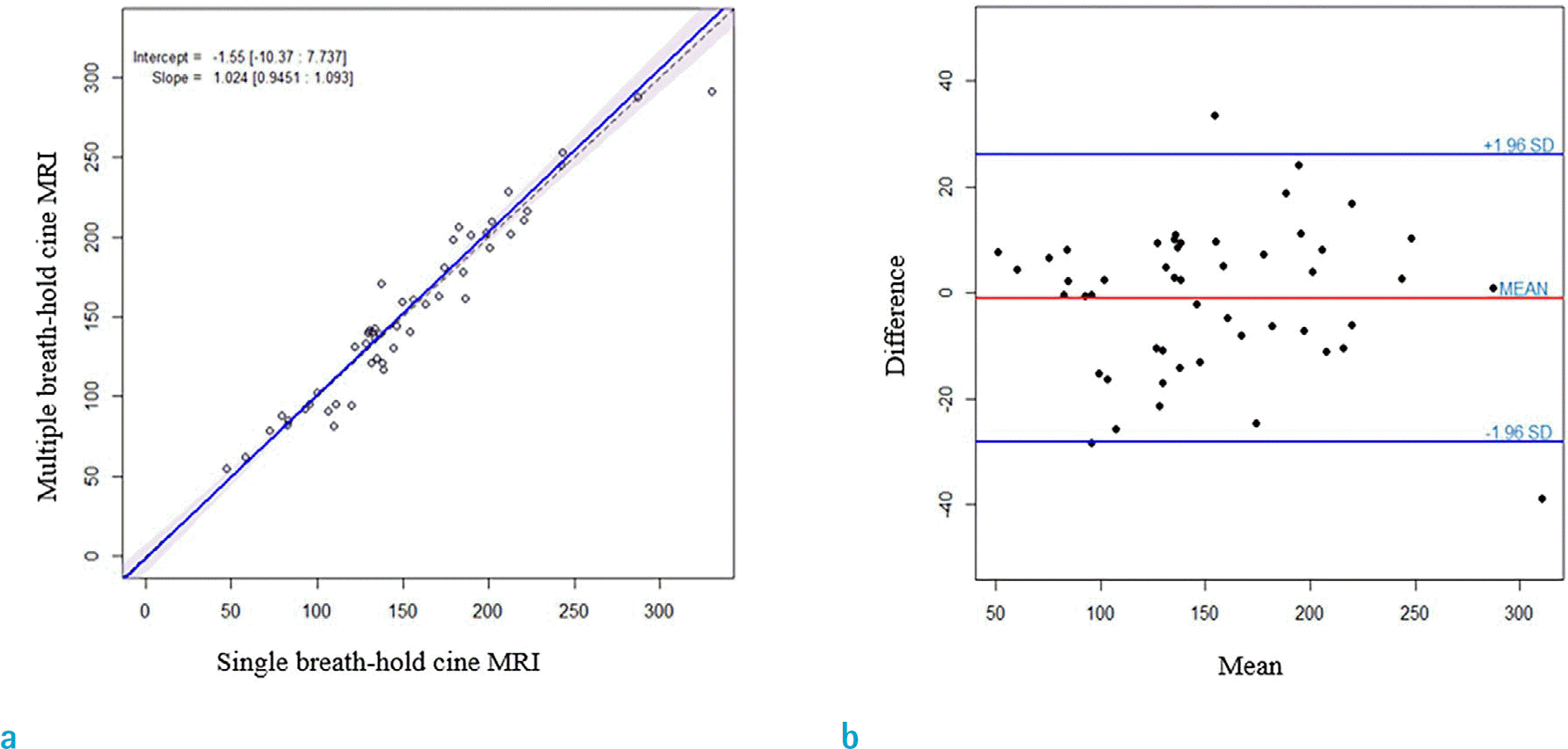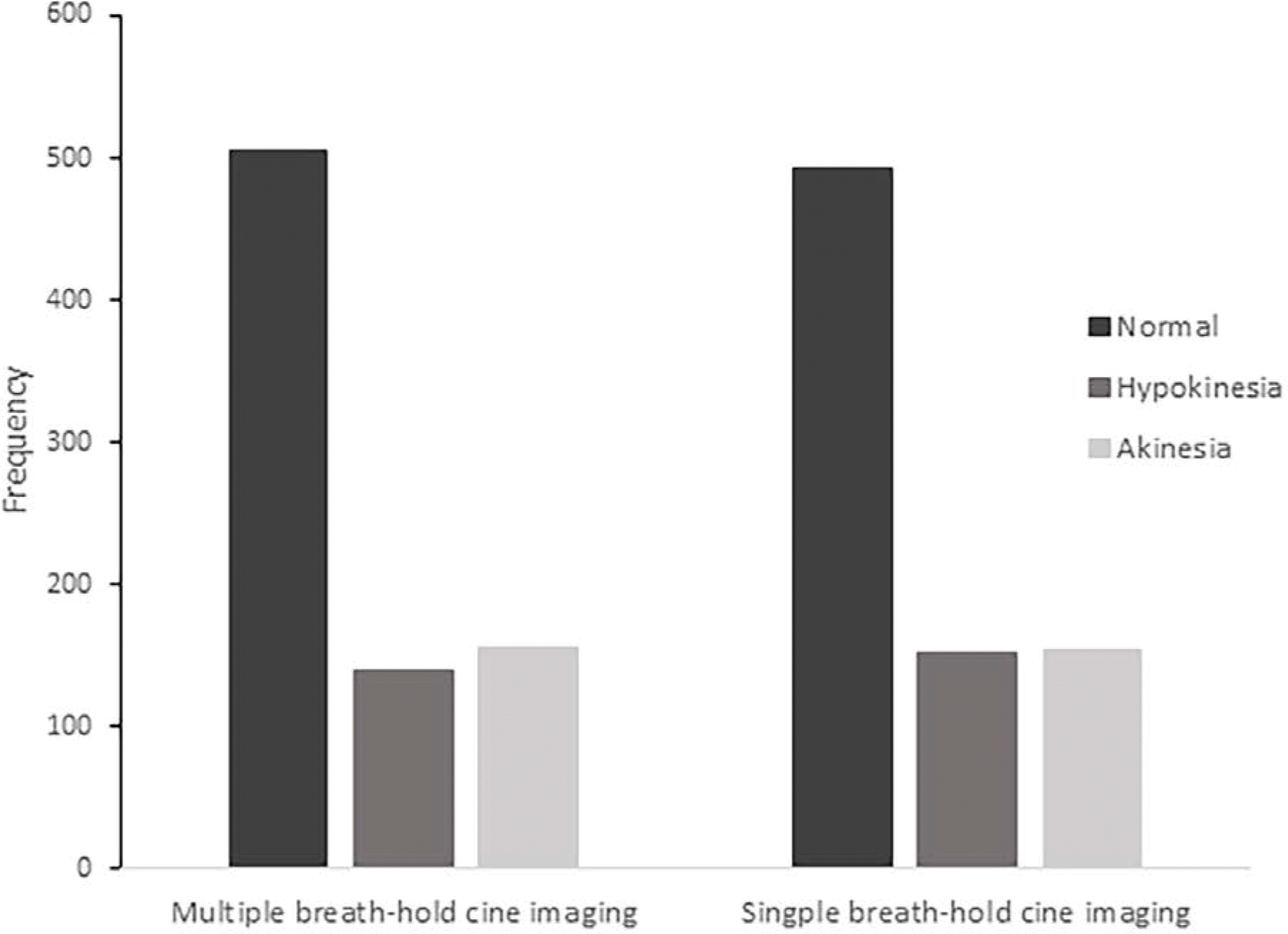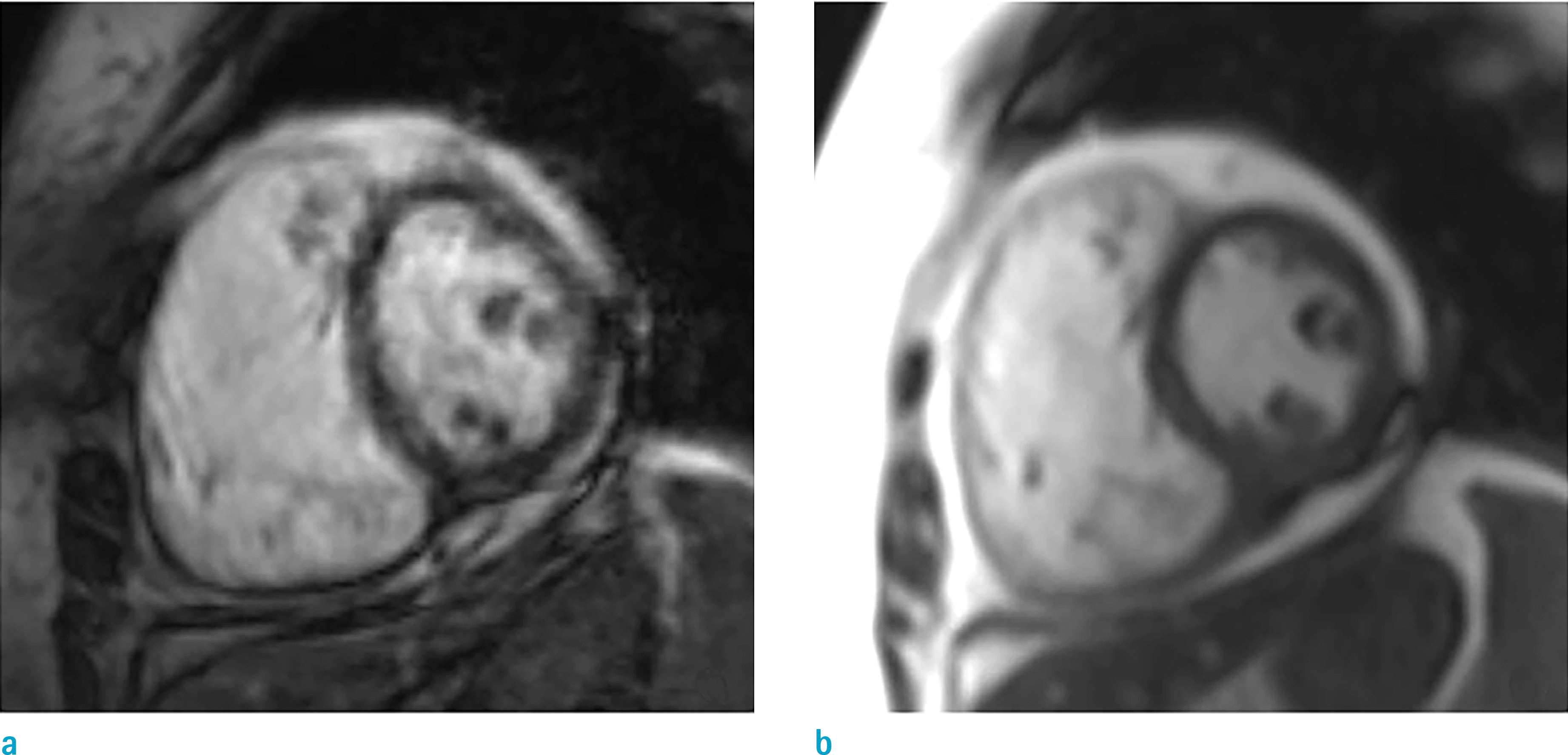초록
Purpose
To evaluate quantification results of single breath-hold (SBH) magnetic resonance (MR) cine imaging compared to results of conventional multiple breath-hold (MBH) technique for left ventricular (LV) function in patients with cardiac arrhythmia.
Materials and Methods
MR images of patients with arrhythmia who underwent MBH and SBH cine imaging at the same time on a 1.5T MR scanner were retrospectively reviewed. Both SBH and MBH cine imaging were performed with balanced steady state free precession. SBH scans were acquired using temporal parallel acquisition technique (TPAT). Fifty patients (65.4 ± 12.3 years, 72% men) were included. End-diastolic volume (EDV), end-systolic volume (ESV), stroke volume (SV), ejection fraction (EF), myocardial mass, and LV regional wall motion were evaluated.
Results
EF, myocardial mass, and regional wall motion were not significantly different between SBH and MBH acquisition techniques (all P-values > 0.05). EDV, ESV, and SV were significant difference between the two techniques. These parameters for SBH cine imaging with TPAT tended to lower than those in MBH. EF and myocardial mass of SBH cine imaging with TPAT showed good correlation with values of MBH cine imaging in Passing-Bablok regression charts and Bland-Altman plots. However, SBH imaging required significantly shorter acquisition time than MBH cine imaging (15 ± 7 sec vs. 293 ± 104 sec, P < 0.001).
Go to : 
REFERENCES
1. Rokey R, Wendt RE, Johnston DL. Monitoring of acutely ill patients during nuclear magnetic resonance imaging: use of a time-varying filter electrocardiographic gating device to reduce gradient artifacts. Magn Reson Med. 1988; 6:240–245.
2. Juergens KU, Fischbach R. Left ventricular function studied with MDCT. Eur Radiol. 2006; 16:342–357.

3. Bak SH, Ko SM, Jeon HJ, Yang HS, Hwang HK, Song MG. Assessment of global left ventricular function with dual-source computed tomography in patients with valvular heart disease. Acta Radiol. 2012; 53:270–277.

4. Niendorf T, Sodickson DK. Highly accelerated cardiovascular MR imaging using many channel technology: concepts and clinical applications. Eur Radiol. 2008; 18:87–102.

5. Wintersperger BJ, Reeder SB, Nikolaou K, et al. Cardiac CINE MR imaging with a 32-channel cardiac coil and parallel imaging: impact of acceleration factors on image quality and volumetric accuracy. J Magn Reson Imaging. 2006; 23:222–227.

6. Cawley PJ, Maki JH, Otto CM. Cardiovascular magnetic resonance imaging for valvular heart disease: technique and validation. Circulation. 2009; 119:468–478.
7. Nassenstein K, Eberle H, Maderwald S, et al. Single breath-hold magnetic resonance cine imaging for fast assessment of global and regional left ventricular function in clinical routine. Eur Radiol. 2010; 20:2341–2347.

8. Vincenti G, Monney P, Chaptinel J, et al. Compressed sensing single-breath-hold CMR for fast quantification of LV function, volumes, and mass. JACC Cardiovasc Imaging. 2014; 7:882–892.
9. Saremi F, Grizzard JD, Kim RJ. Optimizing cardiac MR imaging: practical remedies for artifacts. Radiographics. 2008; 28:1161–1187.

10. Pruessmann KP, Weiger M, Scheidegger MB, Boesiger P. SENSE: sensitivity encoding for fast MRI. Magn Reson Med. 1999; 42:952–962.

11. Bassett EC, Kholmovski EG, Wilson BD, et al. Evaluation of highly accelerated realtime cardiac cine MRI in tachycardia. NMR Biomed. 2014; 27:175–182.

12. Cerqueira MD, Weissman NJ, Dilsizian V, et al. Standardized myocardial segmentation and nomenclature for tomographic imaging of the heart. A statement for healthcare professionals from the Cardiac Imaging Committee of the Council on Clinical Cardiology of the American Heart Association. Circulation. 2002; 105:539–542.

13. Nucifora G, Muser D, Masci PG, et al. Prevalence and prognostic value of concealed structural abnormalities in patients with apparently idiopathic ventricular arrhythmias of left versus right ventricular origin: a magnetic resonance imaging study. Circ Arrhythm Electrophysiol. 2014; 7:456–462.
14. Kozerke S, Plein S. Accelerated CMR using zonal, parallel and prior knowledge driven imaging methods. J Cardiovasc Magn Reson. 2008; 10:29.

15. Theisen D, Sandner TA, Bamberg F, et al. High-resolution cine MRI with TGRAPPA for fast assessment of left ventricular function at 3 Tesla. Eur J Radiol. 2013; 82:e219–224.
16. Wintersperger BJ, Sincleair S, Runge VM, et al. Dual breath-hold magnetic resonance cine evaluation of global and regional cardiac function. Eur Radiol. 2007; 17:73–80.

17. Duarte R, Fernandez-Perez G, Bettencourt N, et al. Assessment of left ventricular diastolic function with cardiovascular MRI: what radiologists should know. Diagn Interv Radiol. 2012; 18:446–453.
18. Feng L, Srichai MB, Lim RP, et al. Highly accelerated realtime cardiac cine MRI using k-t SPARSE-SENSE. Magn Reson Med. 2013; 70:64–74.
19. Niendorf T, Sodickson DK. Parallel imaging in cardiovascular MRI: methods and applications. NMR Biomed. 2006; 19:325–341.

20. Chandler AG, Pinder RJ, Netsch T, et al. Correction of misaligned slices in multi-slice cardiovascular magnetic resonance using slice-to-volume registration. J Cardiovasc Magn Reson. 2008; 10:13.

21. Breuer FA, Kellman P, Griswold MA, Jakob PM. Dynamic autocalibrated parallel imaging using temporal GRAPPA (TGRAPPA). Magn Reson Med. 2005; 53:981–985.

22. Nael K, Ruehm SG, Michaely HJ, et al. High spatial-resolution CE-MRA of the carotid circulation with parallel imaging: comparison of image quality between 2 different acceleration factors at 3.0 Tesla. Invest Radiol. 2006; 41:391–399.
23. Heilmaier C, Nassenstein K, Nielles-Vallespin S, Zuehlsdorff S, Hunold P, Barkhausen J. Assessment of left ventricular function with single breath-hold highly accelerated cine MRI combined with guide-point modeling. Eur J Radiol. 2010; 74:492–499.

24. Eberle HC, Nassenstein K, Jensen CJ, et al. Rapid MR assessment of left ventricular systolic function after acute myocardial infarction using single breath-hold cine imaging with the temporal parallel acquisition technique (TPAT) and 4D guide-point modelling analysis of left ventricular function. Eur Radiol. 2010; 20:73–80.

Go to : 
 | Fig. 1.Passing-Bablok regression chart (a) and Bland-Altman plot (b) of EF obtained from SBH and MBH hold cine imaging. EF values in SBH cine imaging with TPAT showed good correlation with those in MBH cine imaging. EF = ejection fraction; MBH = multiple breath-hold; SBH = single breath-hold; TPAT = temporal parallel acquisition technique |
 | Fig. 2.Passing-Bablok regression chart (a) and Bland-Altman plot (b) of myocardial mass obtained from SBH and MBH cine imaging. Myocardial mass in SBH cine imaging with TPAT was correlated with that in MBH cine imaging. SBH cine imaging with TPAT revealed a tendency to overestimate myocardial mass compared to MBH cine imaging. MBH = multiple breath-hold; SBH = single breath-hold; TPAT = temporal parallel acquisition technique |
 | Fig. 3.Distribution of regional wall motion abnormality evaluated by two acquisition techniques (n = 800 segments in each technique). Regional wall motion abnormality was not significantly different between the two acquisition techniques (P = 0.552). |
 | Fig. 4.Mid-ventricular short-axis images of a 78-year-old female with atrial fibrillation obtained with MBH cine imaging (a) or SBH cine imaging with TPAT (b). MBH cine imaging resulted in blurring of the myocardium. |
Table 1.
Global LV Functional Parameters and Myocardial Mass Meeasured by SBH Cine Imaging with TPAT and MBH Cine Imaging
| SBH cine imaging | MBH cine imaging | P-value | |
|---|---|---|---|
| Mean ± SD | Mean ± SD | ||
| EDV∗ | 195.6 ± 120.0 | 207.8 ± 125.8 | < 0.000 |
| ESV | 115.3 ± 107.4 | 119.7 ± 108.7 | 0.001 |
| SV∗ | 78.9 ± 31.6 | 85.6 ± 35.1 | 0.000 |
| EF | 48.9 ± 18.4 | 48.8 ± 17.8 | 0.942 |
| MM | 152.8 ± 56.9 | 151.8 ± 56.6 | 0.625 |




 PDF
PDF ePub
ePub Citation
Citation Print
Print


 XML Download
XML Download